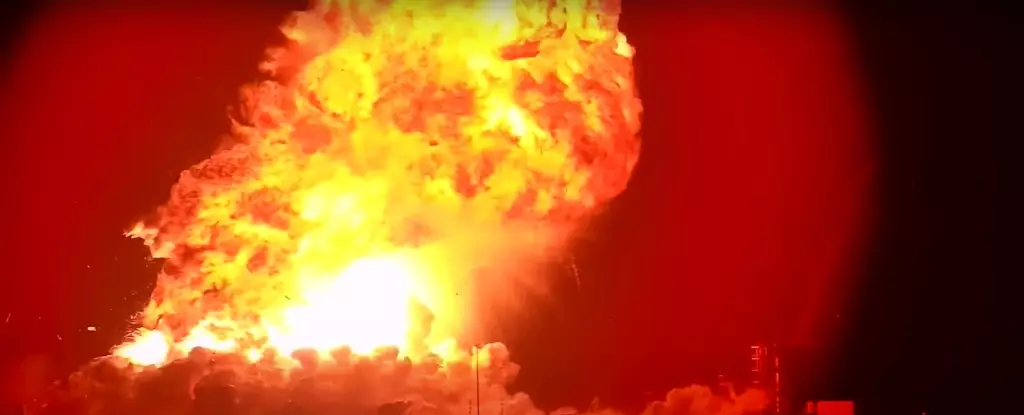On a routine night at SpaceX’s Starbase facility in Texas, a powerful explosion occurred during a static fire test, reflecting the perilous nature of space exploration. The incident, which erupted into a dramatic fireball, serves as a poignant reminder of both the obstacles ahead and the resilience of human ambition. Coinciding with billionaire Elon Musk’s vision of colonizing Mars, this accident is not merely another failure; it is a critical juncture that emphasizes the delicate balance between innovation and risk.
Static fire tests are fundamental preparatory stages before a launch, where a rocket is firmly secured to the ground, allowing engineers to assess engine performance. This latest test, however, resulted in the catastrophic failure of a component known as a Composite Overwrapped Pressure Vessel (COPV) in the Starship’s nosecone. SpaceX’s initial analysis attributes the explosion to this tank, filled with gaseous nitrogen. While investigations proceed, the company remains undeterred, further demonstrating its steadfast commitment to the long-term goal of human exploration beyond Earth.
Staying Safe Under Pressure
Safety protocols during such tests are crucial, and SpaceX was no exception. Prior to the test, a safety zone was established to ensure personnel were clear of the blast area, leading to no reported injuries. This scenario exemplifies a key aspect of SpaceX’s operational philosophy: rigorous safety measures designed to protect its team while they push the boundaries of engineering and aeronautics. Yet, my intrigue lies not only with their current operations but also with the overarching philosophy that drives this ambitious project.
Musk’s nonchalant response to the explosion—summarizing the incident as “just a scratch” on his social media platform, X—suggests a unique approach to failure. In the fast-paced world of space innovation, such cavalier remarks might seem reckless to outsiders, but they embody a culture deeply embedded in the ethos of rapid iteration and learning. In this landscape, failures are not seen as defeats but rather as opportunities for adjustment and enhancement.
Learning from the Flames
SpaceX’s narrative frequently highlights a “fail fast, learn fast” ethos aimed at revolutionary advancements in aerospace technology. This philosophy mirrors the tech industry’s approach to innovation, where early failures—as painful as they may be—often provide insights supposed to lead to breakthroughs. In this context, the explosion at Starbase should not be seen merely as a setback but rather as an essential data point in SpaceX’s continuous effort to refine their rockets.
Despite a series of mishaps—including a previous prototype that perished over the Indian Ocean and subsequent upper stage failures—SpaceX seems to thrive on these challenges. Their impressive skill of catching Super Heavy boosters mid-launch with robotic arms signifies their innovative angle on rocket reusability, promising to reduce launch costs remarkably. This ingenuity is what positions SpaceX as a leader in commercial spaceflight and attracts the support of major stakeholders like NASA.
Musk’s Intriguing Space Odyssey
The road to Mars is inherently fraught with uncertainty, and yet Musk’s vision for SpaceX remains unshakeable. Standing at 403 feet tall, Starship holds the title of the largest and most potent rocket globally, designed for full reusability and an impressive payload capacity. While the journey may be marred by explosions and failures, it reflects a captivating tale of human ambition and technological innovation.
The recent FAA approval to increase Starship launches from five to twenty-five signals significant progression in regulatory confidence regarding SpaceX’s operations. This decision came despite environmental concerns raised by conservationists, showcasing how ongoing technological advancements often navigate a tense relationship with ecological considerations. Such developments highlight an essential question: Can we truly push the boundaries of exploration while maintaining commitment to preserving our planet?
At this stage, as SpaceX continues to learn from each fiery encounter, it undeniably reshapes our approach to space travel. The aspirations for interplanetary colonization become bolder, marked by a firm commitment to pushing past invisible barriers and exploring the unknown. While the explosions and setbacks serve as constant reminders of the risks involved, they also echo humanity’s undying urge to explore and conquer new frontiers.

